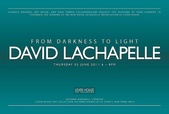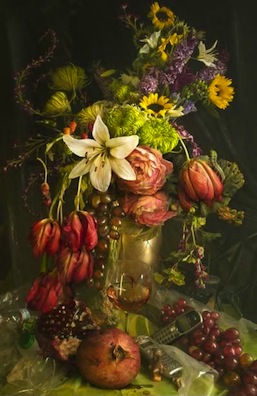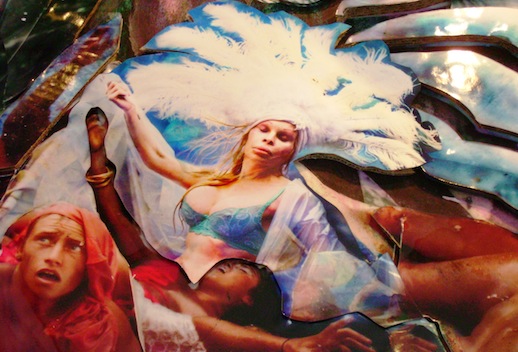
David LaChapelle "From Darkness to Light"
at Lever House
in the Midtown area
This event has ended - (2011-06-02 - 2011-09-02)

David LaChapelle "Early Work: 1984 –1988"
at Michelman Fine Art
in the Upper East Side area
This event has ended - (2011-05-03 - 2011-06-15)
Both the press release for David LaChapelle’s show at Michelman Fine Art and the recent New York Times profile of the artist mention the same name in their very first sentences: Andy Warhol. LaChapelle’s early work at Warhol’s Interview Magazine indeed proved pivotal in launching his career while the visible Pop inheritance has contributed to his success and idolization by many. But there is a uniquely electric feel about LaChapelle’s use of vivid neon color and the jarring displays of contorted bodies in intensely illuminated surroundings. Occasionally, this charged quality is expressed literally, as in an image of his muse, Amanda Lepore, bursting through a TV screen in a flash of bolts or Lady Gaga standing tethered to a mechanical device, emitting sparks from her hair, wrists, and crotch.

LaChapelle is certainly preoccupied with dramatic and even outrageous portrayals of flesh, nature, and religiosity. His early work on display at Michelman captures exaggerated poses of bodies in surreal environments often marked by Christian symbols. The Michelman show highlights LaChapelle’s interest in this imagery from the beginning of his career. Visitors to the gallery are greeted by his massive portrait of Warhol with bibles in the background. Religion interested LaChapelle as a subject early on just as it captivated Warhol in his last years (an issue that emerged during a conversation with one of his Superstars, Ultra Violet). Other LaChapelle collages use images of ancient sculptures as a nod to an enduring preoccupation of past artists, as if to signal that he is not alone in his fixation with the body as an artistic subject.
LaChapelle’s image of a winged male seen from an uncommon angle makes clear his adoration of the virile body. Ripples of energy emanate from the angelic being ready to take flight or call upon his heavenly master. His depictions of bodies are complemented by the sinewy petals of flowers found in several of his works, including three new prints that recall the still lifes that are a hallmark of art history.  LaChapelle’s works, however, use phones, plastic bottles, water guns, a newspaper, and a near empty Starbucks iced coffee cup to tinge the pieces with camp and kitsch. Still lifes tend to be pieces that push the viewer toward an intimate moment of contemplation. LaChapelle’s prints instead bring in the commercial detritus of the outside world.
LaChapelle’s works, however, use phones, plastic bottles, water guns, a newspaper, and a near empty Starbucks iced coffee cup to tinge the pieces with camp and kitsch. Still lifes tend to be pieces that push the viewer toward an intimate moment of contemplation. LaChapelle’s prints instead bring in the commercial detritus of the outside world.
Similar themes of body and spirit are found in LaChapelle’s exhibition at Lever House. Three agglomerations of small photographs of nude bodies point to LaChapelle’s fascination with masses of contorted flesh. Pinkish photographs of males are affixed to a window across the lobby from a circular mass of swirling violet women. As LaChapelle states, the arrangements are “cell-like as if seen through a microscope,” although Guy Trebay notes that these assemblages could evoke “more ominously, viral replication.” This characterization is plausible: LaChapelle’s adoration of the vigorous, unclothed body becomes linked to the virus that can destroy it. Less subtle is the abject anguish seen in the yellow, orange, and burgundy images of males pinned to a nearby wall, some holding the posture of the crucified Christ while others’ heads are crowned by halos.

The opening of the Lever House show was a testament to LaChapelle’s enduring popularity. The artist welcomed visitors like Uma Thurman, Daphne Guinness, Fab 5 Freddy, and Lee Quinones. Camera flashes greeted nightlife superstars like Amanda Lepore, Kenny Kenny and Darian Darling, who covered the opening for her weekly column and will host the upcoming Warhol Experience. When I later asked Kenny about LaChapelle’s body of work, he described the artist as a “hard worker” who “stuck to his vision,” one that “will help to define this time.” At the packed opening, one could not help but bump into chains of small photographs dangling from the ceiling, a LaChapelle piece that resembled a Pop mutation of a school art project. Some grumbling attendees dismissed the works as half-hearted gestures. I remained curious, however, and returned on a much quieter weekday afternoon. In doing so, I relished seeing the grimaces of the building’s corporate visitors when they realized that the links in the photo-chain featured completely nude male and female bodies.
At the opening I was also grateful for the opportunity to chat with Lepore, who appears in some of LaChapelle’s most recognized works. She also emerges in Raft of Illusion: Raging Toward Truth, a collage of photographs in relief that together depict a mass drowning, a rather flamboyant homage to Géricault’s The Raft of the Medusa. A dark horse looms in the top right corner, possibly an avatar of death ready to accompany the seafarers to their doom. The teal waves and foam crescents that make up the watery tumult are jagged and pulsate with furious energy, adding to the clear distress of the victims in their death throes.

In creating works that deal with death and kitsch as well as the corporeal and the ethereal, the Warholian inheritance is clear. When I asked the Warhol scholar Patrick Smith about the ties between LaChapelle’s aesthetic vision and his hero, he replied, “Like Warhol, LaChapelle’s works are indelible, collaborative, and seductive. Their sly camp humor celebrates repertories of diva-muses, transcending marginal inane artifice as an epicenter of glitzy glamour.” The early works on display at Michelman hint at LaChapelle’s intent to infuse the body and its surroundings with a luminescent vitality. The success of his electric Pop enterprise is discernible in how his work activates the glass and steel corporate space of the Lever House lobby. Although perhaps missing the radiance of some of his more famous photo spreads, the purple and pink bodies-cum-cells, the reddish chains, and the white and blue collage add an undeniable glow to the modernist sanctuary.

Comments